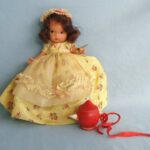The modern novel Invisible Man by Ralph Ellison defines Black America’s struggles for equality during the mid twentieth century. The main protagonist takes the form of an unnamed Southern black man who discovers his true self as the novel progresses. Several symbols emerge throughout the book and are repeated often to remind the narrator of his past and what the future holds. The concept of blindness remains the overall theme and one that periodically takes form in the narrator’s quest through Harlem. Another major symbol and overlying theme that sparks interest and agitates the narrator on a regular basis can be found in the dancing Sambo doll.
At first the dolls appear to move by themselves, only later does the narrator realize a string attached to the back moved the dolls. It was Clifton, riding easily back and forth in his knees, flexing his legs without shifting his feet, his right shoulder raised at an angle and his arm pointing stiffly at the bouncing doll as he spieled from the corner of his mouth” (433). Brother Clifton, once a mighty member of the brotherhood was peddling Sambo dolls on the street corner. The Sambo doll implies that black Americans continue to live like marionettes, their motions determined by white puppeteers. Only after this scene does the narrator gain a moment of clarity and realizes that the Brotherhood has been using him as a tool.
The Sambo dolls also bring the grandfather’s words to light from the beginning of the novel. “I want you to overcome ’em with yeses, undermine ’em with grins, agree ’em to death and destruction, let ’em swoller you till they vomit or bust wide open” (16). The doll represents the exact lazy obedient slave mentality the old grandfather was saying on his deathbed. A few short moments after the dolls are being hawked Clifton is gunned down by police. This killing represents the failed message the narrator was given by his grandfather in the beginning of the novel.
Another instance of the doll is referred to in chapter eleven when our nameless narrator finds himself in the factory hospital. He is the black man on the strings representing the Sambo doll sitting in the hospital bed/box. His doctors are administering electric shock therapy via wires connected to his body. “Look, he’s dancing, someone called” followed by “They really do have rhythm, don’t they? Get hot, boy! Get hot! It said with a laugh” (237). The hospital event happens earlier in the book than the actual doll encounter with Clifton. The message is the same: White Americans are controlling blacks to do what they want when they want.
The initial encounter with Clifton and the Sambo dolls represent a powerful form of symbolism. This symbolism is also the first time the narrator feels the Brotherhood has cheated him. While starring at the doll the narrator decides upon the funeral for brother Clifton. The narrator openly chooses to defy the Brotherhood by holding a funeral service for Clifton. This service attempts to prevent Clifton from slipping into invisibility while allowing our protagonist to act individually for the first time. The Brotherhood’s rejection of the massive anger built up by the death of Clifton shows the new international focus of the Brotherhood, effectively destroying their Harlem resistance branch. The Sambo doll represents the turning point for the narrator as he slowly accepts his new life of invisibility.
Works Cited
• Ellison, Ralph. Invisible Man. Random House Inc.: New York, 1952.

